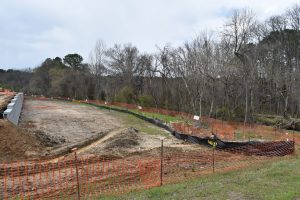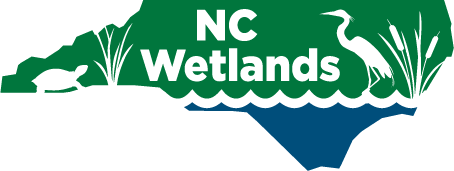I Have a Wetland, Now What?
Changes to wetlands require permits
Changes to North Carolina wetlands require permits because wetlands hold water, and activities affecting the quality of that water may affect downstream users. To provide guidelines and set limits on proposed wetland changes to benefit all people, both state and federal governments have established rules for wetlands in North Carolina. The North Carolina Division of Water Resources (DWR), North Carolina Division of Coastal Management (DCM), and the United States Army Corps of Engineers (USACE) are the agencies in North Carolina that enforce wetland rules and issue permits for projects that meet the rule requirements and do not violate established water quality standards. Obtaining permission to modify a wetland may mean that replacement of that wetland must be done elsewhere to make up for the loss in wetland functions (mitigation). Rules regarding wetlands in North Carolina are found in sections 401 and 404 of the Clean Water Act (CWA), the Coastal Area Management Act (CAMA), and the North Carolina administrative codes (for Isolated/Non-404 wetlands).
Wetlands in North Carolina provide protection from flooding and erosion, places for recreational activities, habitat for plants and animals including human food sources, and cleansing of water before it enters rivers, estuaries, and the ocean. Yet, rapidly increasing human population in North Carolina has led to an average 770 permit requests per year (since the year 2000) to modify wetlands.
Learn more about why wetlands matter: functions and benefits of North Carolina’s wetlands.
Have plans to make changes to your wetland?
Because they involve water, changes to wetlands in North Carolina are regulated by the 401 and Buffer Permitting Branch of the Division of Water Resources (DWR), the North Carolina Division of Coastal Management (DCM), and the United States Army Corps of Engineers (USACE). One or more of these agencies may require permit applications for proposed changes to a wetland depending on the type and size of the impacts, type and size of the wetland, and the wetland location. The type of legislation, the agency responsible for enforcing the legislation, and regulated activities are summarized in the table below.
(This information focuses primarily on wetlands. Impacts to streams, ponds, lakes, and riparian buffers are also regulated, and similar permitting requirements may apply.)
| Legislation | Responsible Agency | Regulated Activity |
|---|---|---|
| Section 404 Clean Water Act (1972) | US Army Corps of Engineers (USACE) | Discharge of dredged or fill materials into waters (streams, wetlands, and open waters) of the United States |
| Section 401 Clean Water Act (1972) | NC DEQ Division of Water Resources | Any federally permitted activity that results in discharge to waters of the United States within North Carolina |
| NC Coastal Area Management Act (1974) | NC Division of Coastal Management | Development in designated “Areas of Environmental Concern” in the 20 coastal counties |
| Division of Coastal Management State Dredge and Fill Act (1969) | NC Division of Coastal Management | Filling or dredging in estuarine waters, tidelands, marshlands, and state-owned lakes |
| Title XIV: 1990 Food, Agriculture, Conservation and Trade Act (Swampbuster) | Agricultural Stabilization and Conservation Services | Conversion of wetlands for the purpose of agricultural production |
 Types of activities that may require one or more of the above permits include:
Types of activities that may require one or more of the above permits include:
- Any disturbance to a wetland
- Placement of any material within a wetland, stream, or open water, including material that is necessary for construction, culvert installation, causeways, road fills, dams, dikes or artificial islands, property protection, reclamation devices and fill for pipes or utility lines.
- Temporary impacts including dewatering or dredged material prior to final disposal and temporary fill for access roads, cofferdams, storage, and work areas.
- Any disturbance to the bottom or sides of a stream.
- The damming of a stream channel to create a pond or lake.
Who can help me figure this out, and how do I apply for a permit?
NC DEQ Division of Water Resources, US Army Corps of Engineers, and NC Division of Coastal management are each responsible for reviewing and issuing permits. They each have well trained staff that are available to help you through the process. Below are links to general permit information, contact information, and permit applications for each of these agencies.
United States Army Corps of Engineers
NC DEQ Division of Water Resources
NC Division of Coastal Management
Want to protect or restore your wetland?
If you have a wetland on your property that you want to protect in its current condition or improve its condition, there are a few options to consider.
Conservation Easements
Conservation easements are legally binding agreements designed to provide long-term protection of natural resources within a designated boundary. The terms of a conservation easement can vary, but in general they protect the natural area from being developed, farmed, timbered, or mined. The agreement usually allows low-impact recreational activities like hunting, fishing, hiking, and educational uses. The North Carolina DEQ Stewardship Program manages the conservation easements for North Carolina.
Land Conservation Groups
North Carolina has many groups whose goals are to protect and preserve natural environments, including wetlands. If your goal is to protect and preserve the wetlands on your property, working with a conservation group may help you achieve this. Below is a list of land conservation groups in North Carolina (not a comprehensive list).
- Bald Head Island Conservancy
- Blue Ridge Conservancy
- Carolina Mountain Land Conservancy
- Catawba Lands Conservancy
- Conservation Trust for North Carolina
- Davidson Lands Conservancy
- Eno River Association
- Foothills Conservancy of North Carolina
- Land Trust for Central North Carolina
- Land Trust for the Little Tennessee
- National Committee for the New River
- North Carolina Coastal Land Trust
- Tar River Land Conservancy
- Triangle Land Conservancy
- The Nature Conservancy in North Carolina
Restoration/Enhancement
Wetlands on your property may have been previously impacted by natural or man-made events. Depending on how severe the impacts were, actions may include improving the quality of the wetlands or restoring them to their original condition. North Carolina has a state agency, the Division of Mitigation Services (DMS), that works with willing landowners to restore and protect wetlands and streams that can be used toward compensatory mitigation requirements which are part of the state and federal 401/404 permitting programs. Likewise, multiple private companies provide wetland restoration services for individual projects or as part of larger projects such as wetland mitigation banks. North Carolina’s approved mitigation banks and the companies that have designed or are managing them can be found here.

